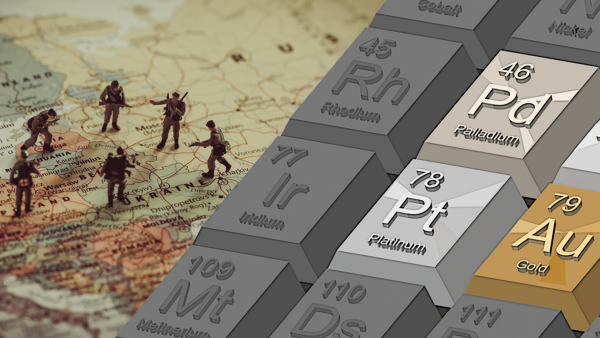Worries over the state of global resources as the Russian invasion of Ukraine enters its second week have been growing rapidly, and rightfully so, as we realize just how significant both countries' contributions are to the global economy.
During the weeks leading up to the current Russian military offensive in Ukraine, economists put huge efforts to warn the world of what the war could mean to the global economy.
Not only because the world has not yet recovered from the devastating impact of COVID19, but also because of what both Russia and Ukraine provide the economy with.

Udokan copper industrial complex under construction in eastern Siberia's Zabaikalsky region. (NATALIA KOLESNIKOVA/AFP)
In terms of food security, both countries are major producers and exporters of grains, wheat, and corn products. In terms of energy, Russia has the world's largest reserves of natural gas, it is also the third-largest producer of oil in the whole world, most of which are exported to EU countries.
While disruptions, shortages, or price increases of any of these resources are enough to trouble the already struggling global economy in case the war continues for a few months, other less-discussed commodities can have a major negative impact on an endless number of industries as well; that is precious metals.
Russian and Ukrainian Precious Metals
Considering the geographical proximity between Russia and Ukraine, it is only normal to see similarities in terms of the natural resources each country has. Yet, they differ in terms of quantity and processing.
1. Gold
Not only is Russia the world's third-largest producer of gold, but it also has the fifth largest gold reserves. This ranking in terms of gold explains the soaring prices of gold ever since the crisis started, as gold prices jumped by 6.5% during the month of February.
2. Platinum
Russia is the second-largest producer of platinum around the world with 10% of the global reserves.
Platinum is used as a catalyst in the production of detergents, fertilizers, plastics, explosives, and many types of acids.
Recently, platinum prices have reached the highest points in 9 months.
3. Palladium
Russia also has the lead in terms of producing palladium with 50% of the global production, mostly carried out by the mining giant Norilsk Nickel, which has not been sanctioned so far.
This metal is widely used in a number of industries, such as automobile manufacturing. About 85% of palladium produced in the world is used in catalytic converters in car exhausts.
Palladium is also used in making jewelry, dentistry, watch-making, producing blood sugar test strips, aircraft spark plugs, surgical instruments, and electrical contacts.
In the wake of the Russian-Ukrainian war, palladium prices have jumped by more than 24% in a matter of a week.
4. Nickel
Nickel's prices have jumped to the highest rates in 11 years. It is also one of the key supplies by Russia's Norilsk Nickel and is used by almost every country in the world to make coins, wires, gas turbines, batteries, mobile phones, medical equipment, transport, buildings, power generation, jewelry, and rocket engines.
5. Magnesium
This metal is crucial for the automobile industry as it helps in manufacturing car seats. It is also an important component of luggage, laptops, cameras, and other power tools.
Russia is the world's 2nd largest producer of Magnesium, while Ukraine comes in the 6th rank.
Source
6. Aluminum
Here is another metal with increasing prices due to the war in Ukraine. Aluminum is widely used for packaging food, medication, and beverages.
7. Steel
Russia is the fourth-largest steel producer in the world with 73.4 million tonnes per annum (mtpa), which is used for cars and construction products, refrigerators and washing machines, cargo ships, and surgical scalpels.
8. Copper
Used for railings, pipes, furniture, wires, jewelry, and many tools, shortages of production in copper from Russia could change global prices and cause disruptions in many industries.
9. Neon
Neon is one of the metals that go into micro-chips manufacturing, exerting extra pressure on the industry that has already been struggling for years, and affecting the production of electronics, cars, and many others.
About 90% of the global supply of neon comes from Russia, while about 60% of it is purified in the industrial city of Odessa in Ukraine, which has been under heavy shelling for about a week now.
10. Iron Ore
About 10% of the world's Iron Ore is produced in Russia, while 4% of it is produced in Ukraine.
11. Titanium
Titanium is one of the most crucial metals in this day and age, as it gets into the making of aircraft, armor plating, naval ships, spacecraft, and missiles.
Russia is the world's third-largest producer of Titanium while Ukraine comes in 5th place.









